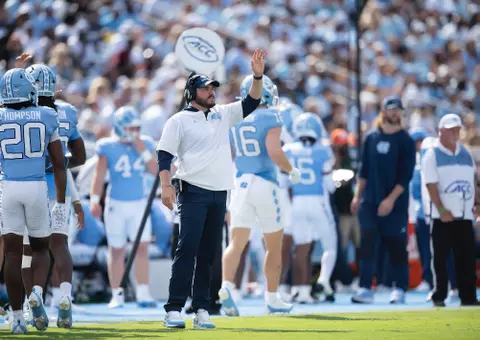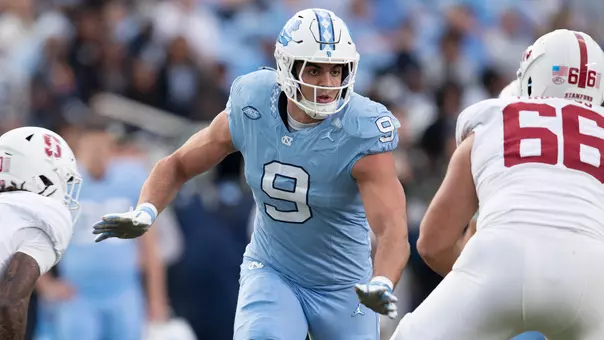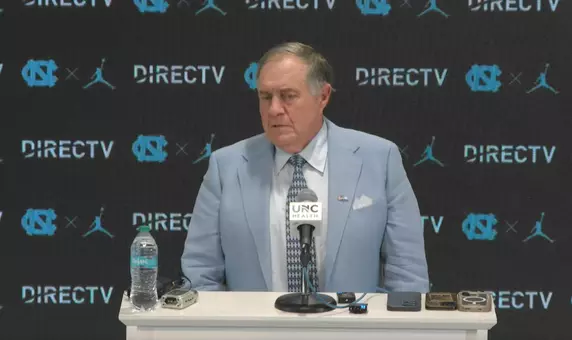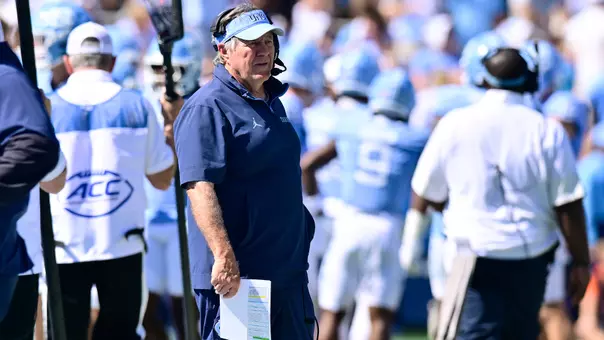University of North Carolina Athletics
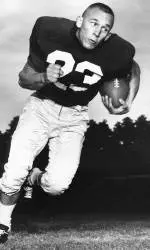
Golden Anniversary Of A Memorable Win
November 4, 2009 | Football
Nov. 4, 2009
By Clifton Barnes
The Carolina-Duke football rivalry was one of the top football rivalries in the South, if not the top, during the first half of the last century. But, by end of the 1950s, Duke had beaten the Tar Heels eight of the previous nine times the two teams had played.
The 1959 UNC team was determined to change the trend. The Tar Heels were ranked third in the national preseason poll as expectations were higher than at any time since the Charlie Justice years in the 1940s.
Just weeks before the Tar Heels were to start the season, their beloved, accomplished coach and Carolina alum Jim Tatum ('34) died of Rocky Mountain Spotted Fever, despite the fact that players were giving blood as often as they could to help him.
The senior-laden team suddenly had a new coach, Jim Hickey, and their hearts were heavy. Things did not go well from the start as the Heels lost their first two games. After Carolina fell for the fifth time, this one to Miami, to drop to 3-5, Hickey was hung in effigy by a group of students.
The Tar Heels came back with a vengeance to defeat lowly Virginia 41-0 but then had to play favored Duke in the last game of the season with a chance to finish at 5-5.
A sports writer for the Durham newspaper wrote that the whole season was wrapped up in the outcome of the Duke game. "What happened in the other nine games won't matter," it read. "All the alumni are talking about is beating Duke."
That's all the students were talking about as well. "There was a lot of excitement leading up to the game," said Jim Copland ('62). "The rivalry was so intense plus the game was going to be on national television on Thanksgiving Day." With a short week between games, and some students leaving town for the holiday, a lot was crammed into a short period of time.
Carolyn Kelley ('61), described in the The Daily Tar Heel as a 20-year-old blue-eyed blonde from Arlington, Va., was selected as the Beat Dook Queen, which at the time was considered by most a bigger honor than Homecoming Queen.
"I came to Carolina as a junior - they didn't admit girls as freshmen and sophomores back then," Carolyn Kelley Eberdt said. "I just wanted to do everything and the Duke-Carolina game was the most exciting thing in the world. It just consumed all."
She said she went to basketball games but that it was all about football at that time. "All week you looked forward to it - hardly thinking about anything else," said Kelley Eberdt, who, while she dated a couple of Carolina football players in college, ironically ended up marrying a former Duke player named Art Eberdt. "I felt like a Tar Heel immediately - I had never experienced anything like the enthusiasm and loyalty to the school. It has stayed with me all these years. I take a lot of ribbing from the Duke fans in my family but at least Carolina usually comes out on top."
Queen Kelley, who was sponsored by her Pi Beta Phi sorority and was the Pi Kappa Alpha's "Dream Girl," rode and waved perched atop the backseat of a Thunderbird in the annual parade.
It was a large Beat Dook Parade - complete with floats, cars, bands and even ROTC drum and bugle and drill teams - held two days before the game. "Participation was really good," said Copland, who was the parade chairman and a member of the long-time sponsor Pi Kappa Alpha. "There were a lot of quite good floats that were sponsored by fraternities, sororities, dorms and organizations on campus. A lot of thought and effort went into them."
Sigma Nu's float showing some Tar Heels slaughtering the devil for Thanksgiving dinner won best-all-around. Devil funeral themes and beatnik scenes otherwise dominated. One sign read, "If you think we're beat, wait till you see Dook."
It was prophetic.
"I remember it like it was yesterday afternoon," said Wade Smith ('60), who was a second team All-ACC halfback. "We got on the bus to go to Duke (fully dressed for the game). It was absolutely quiet. It was ominous. We were poised and ready to go."
He said there was no doubt the players were thinking of Tatum and what might have been had he not died just weeks before the season was to begin. The team wanted to show everyone in the country what type of performance they were capable of giving.
Coach Hickey knew what was going through the players' minds. "Hickey was not much of a motivator," said Moyer Smith ('61), who played on the team and was class president. "But before the Duke game, he told us, `the big man would have wanted you to win this one.'"
If any of the players needed additional motivation to start the game, that was it.
"We ran out on the field and nearly killed them," Wade Smith said.
The Tar Heels scored the first three times they touched the ball and held a commanding 27-0 lead at the half.
Wade Smith said at halftime the Tar Heels assumed that Duke would come out like demons possessed and that UNC would be fortunate to hold on. They decided to start off the second half as if the score was 0-0. "We lined up to receive the kickoff," he said. "I was on the right side and Don Klochak was on the left. It came down to him and he went all the way for a touchdown, untouched."
The game was well in hand after the 93-yard return and the starters came out of the game. "The coaches did what they could to hold it down," Wade Smith said.
But the second and third-team players wanted in on the action as well. In fact, it was a fifth-string fullback named George Knox who scored the final touchdown on a 32-yard run in the fourth quarter.
"We could have scored a couple more times if we wanted to," Moyer Smith said. . With the score 48-0 after the Knox touchdown, the players did want a couple more points.
The two-point conversion had only been allowed in college football for a year so it was a novelty and would allow the Tar Heels to reach 50.
Bob Shupin had been sent into the game to kick the extra point but backup quarterback Ray Farris Jr. ('62), whose father played on the 1929 team that beat Duke 48-7, wanted no part of it.
"In the huddle, I just said, `Do you wanna go for two? Let's go for two' and they all said `yeah,'" Farris said.
Moyer Smith, who served as an assistant coach in the 1960s and later became president of the UNC Educational Foundation, said everybody but the coaches wanted to go for two. "We were all yelling, `Go for two! Go for two!'' he said. "That was a statement, getting to 50."
Farris ran an option to the fullback, pulled it out and ran it in himself to make it 50-0.
Farris said he didn't view it as bad sportsmanship. "We thought 50 sounded better than 49," he said. "If they were in the same situation, I'd expect them to do it too. It was just Carolina-Duke, that's all."
And maybe it helped give them some redemption for a nightmare season. UNC Chancellor Emeritus Robert House thought the score was appropriate. After the game, he said the 1959 game "completely made up for the 1935 game" when Carolina lost 25-0 and was knocked out of the Rose Bowl "because we doubled the score."
Oddly, Duke coach Bill Murray didn't seem so upset about that but he was angry that Carolina put most of their starters back in at the end of the game. He was convinced that the Tar Heels were trying to score again but Hickey had put the seniors back in so they'd be on the field at the end of their final regular season game.
"I know for a fact that they weren't trying to score," said former Greensboro News writer Irwin Smallwood ('47), who covered the game from the sideline. "I was standing right next to Hickey and I heard him tell the quarterback (senior Jack Cummings) to fall on the ball."
Wade Smith said, as a senior, it was an honor to go back in and finish the game. "The coach specifically said, `Don't score,'" he said. "We fell down to keep from scoring. We could have scored on one leg that day."
He said, nevertheless, the incident soured the relationships of the coaches. It did not affect the relationships between the players however, he said.
"Duke had a great group of boys," Wade Smith said. "We all knew them and appreciated and respected them. It was never about hate among the athletes but we didn't pull any punches at all on the field."
Off the field, some of the guys went out together. "I knew half of the Duke players fairly well," said Butch Fowler ('61), who served as Carolina team manager all four years. "Two of my best friends were on their team. I used to go to Duke and hang out with `em."
Moyer Smith said a good number of players on both Duke and Carolina were from North Carolina, many of whom had played with or against each other in high school.
Farris said even the players from out of state were friends with each other. "The next day after the game, one of our players, Gib Carson, rode home to Pennsylvania for the rest of Thanksgiving break with Duke's quarterback and fullback," he said.
The students were rough with each other, he acknowledged. "But I never felt Duke was dirty," he said. "I thought it was a great rivalry."
Many of the former players use the past tense when talking about the Carolina-Duke football rivalry.
The Tar Heels have beaten the Blue Devils 31 times since 1970, which includes winning 18 of the last 19 times the traditional rivals have played.
It got to a point that Duke and Carolina were never good at the same time, said Al Featherston, longtime Durham writer and Atlantic Coast Conference historian. "But ultimately it was a decline in Duke football that hurt the rivalry," he said. "When (Duke coach Bill) Murray retired following the 1965 season, Duke made a secret decision to deemphasize football. They were trying to make Duke into a Southern Ivy League school... so, they put no money into the program."
But Duke coach Steve Spurrier brought some excitement and controversy back to the series in 1989. Spurrier admitted to running up the score on the Tar Heels. He gathered the Duke team in front of the scoreboard after the game at Kenan Stadium to take a picture in front of the 41-0 score.
Spurrier said he wanted the Blue Devils to win 51-0 to eclipse the 50-0 Carolina win in 1959. That sort of thing is unlikely to happen under new Duke coach David Cutcliffe considering his renowned "nice-guy" reputation but Duke is showing more interest in football with the hiring of the successful coach.
With the long memories of Carolina and Duke faithful, the revitalization of Blue Devil football under a strong new coach, and the intense basketball rivalry, perhaps some of the magic from the golden era of the football rivalry can be re-lived. If not, at least there's Homecoming ... and the never-to-be-forgotten story of a redemptive 50-0 Carolina victory on Thanksgiving Day in 1959.
(Barnes, who was sports editor of The Daily Tar Heel in 1981-82, is a 1982 UNC grad with degrees in Journalism and Political Science. He has won more than 60 national, regional and statewide journalism awards. The Rocky Mount native now lives in Cary and operates his own communications business - www.cb3media.com.)











